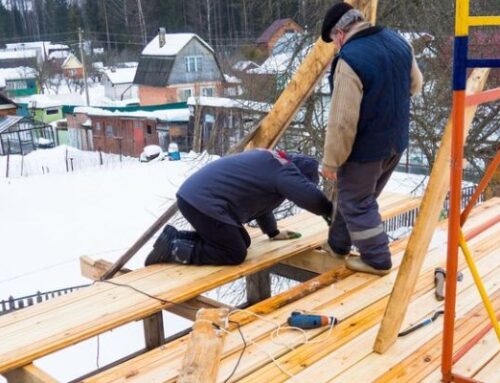It is right to start thinking about your deck when the weather starts to cool down. During this period, a winter deck replacement may be required in the case of damage. As a homeowner, you must prepare adequately to ensure that the replacement process is efficient and completed on time.
Preparing For a Winter Deck Replacement: Essential Tips for Homeowners
To ensure a smooth and successful project, you must carefully plan and pay attention to detail when preparing for a winter deck replacement. Here are essential tips that will help homeowners get ready for a winter deck replacement.
1. Plan in advance
For a winter deck replacement project, you must begin planning before the winter season sets in. The winter weather can be unpredictable, which is why you must take your time to analyze how long the project will take and how to go about it. You must factor in extra time as well in case there is a delay.
When you start planning before the commencement of winter, you ensure that your project is safe from setbacks that the weather might cause. Generally, planning is an approach that will help you better manage the construction timeline. As a result, you will be able to complete the project smoothly and efficiently even in the face of the challenges during winter.
2. Hire a professional

Deck replacement is no simple task that you should take on by yourself. It is recommended that you seek the assistance of a professional for this project, especially if you lack experience. Choosing to engage an expert when preparing for a winter deck replacement will ensure that you complete the project.
Also, you must consider professionals with the necessary licenses and insurance coverage before choosing. Experts with a well-established reputation in the industry will also offer you protection and peace of mind. For your deck replacement to be able to withstand the challenges of the cold, wet, and snowy conditions, you need the help of a professional.
3. Get the necessary permits
Before starting your deck replacement project, you must contact your local building department to obtain the necessary permits. You must take this step to ensure compliance with local regulations and codes. The timeline of this project can also be influenced by getting a permit on time.
Additionally, it is recommended that you initiate that process in advance because of the time-consuming nature of the permitting process. By doing so, you give yourself enough time to navigate any procedural requirements. By securing the necessary permit before the commencement of your deck replacement, you ensure a seamless progression of the project.
4. Choose the right materials
Choosing materials that are strong enough to resist the challenges posed by cold, damp, and snowy conditions is key. Some of the current top deck materials you can find in the market at this moment include pressure-treated wood, composite decking, and PVC decking, all renowned for their durability in harsh climates.
Pressure-treated wood is treated with chemicals to resist decay and moisture. Composite decking is made up of wood fibers and recycled plastics and is ideal for winter conditions. PVC decking, made from polyvinyl chloride, is weather-resistant, moisture-resistant, and has low maintenance requirements. Any of these materials will be a good choice.
5. Design for snow removal
To make snow removal easier, carefully design the layout and construction of your deck. One obvious benefit of doing this is that the incorporation of a roof or awning will shield your deck from snow accumulation while protecting it from the elements. With this approach, the usability of your outdoor space is optimized and snow removal is made easier.
Additionally, using a sloping design that directs water and snow away from your home is good. This prevents moisture from seeping into your residence. By implementing these design elements, you ensure that your deck is ready for the winter season while simplifying the essential task of snow removal.
6. Use winter-friendly fasteners
Make use of fasteners that are resistant to corrosion, especially in the moisture conditions of winter. Ideal choices for these circumstances include stainless steel fasteners or screws and nails with protective coatings. Stainless steel fasteners are popular for being resistant to rust and corrosion.
Additionally, consider fasteners coated with protective substances that form a barrier against moisture. These coatings provide an extra layer of defense against rust. Winter-friendly fasteners further safeguard the structural integrity of your deck during winter’s challenging conditions.
7. Ensure proper insulation and ventilation
To protect the structural integrity of both your deck and home, you must ensure that effective insulation and ventilations are put in place. These measures are crucial in mitigating problems like ice dams that can cause substantial damage.
Proper insulation maintains a consistent temperature on your deck’s surface. It helps in preventing ice from forming and minimizes the risk of damage to your deck’s structure. Adequate ventilation, on the other hand, helps in regulating temperature and moisture, thereby reducing the likelihood of ice dams forming on your deck and roof.
8. Work on the deck footings

Another essential tip to help you when preparing for winter deck replacement is to verify that the deck footings are excavated to an adequate depth. This will thwart the occurrence of frost heave. Frost heave can affect the stability of your deck and its overall structure. The specific depth required for these footings varies according to the region’s frost line.
Therefore, it is advisable to consult the relevant local building codes for precise guidelines. These codes stipulate the minimum footing depth necessary to prevent frost-related issues, ensuring your deck’s resilience in the face of freezing temperatures and safeguarding against costly damage and repairs.
Conclusion
You must carefully plan and pay attention to detail before preparing for a winter deck replacement. By considering materials, professional expertise, permits, and weather-specific preparations, you can ensure a strong and durable winter deck.






